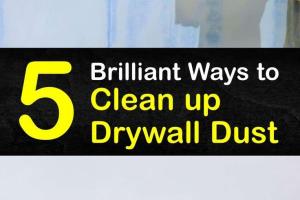The Ultimate Guide to Eliminating Drywall Dust and Preventing Its Spread

-
Quick Links:
- Introduction
- Understanding Drywall Dust
- Why Drywall Dust is a Problem
- Step-by-Step Guide to Getting Rid of Drywall Dust
- Preventing Drywall Dust from Spreading
- Best Tools and Products for Dust Control
- Case Studies and Expert Insights
- FAQs
Introduction
Drywall dust is an inevitable byproduct of any renovation or construction project involving drywall. While it may seem harmless, the fine particles can pose significant health risks and lead to extensive cleaning challenges. In this comprehensive guide, we will explore effective strategies to get rid of drywall dust and prevent its spread, ensuring a cleaner and healthier environment.
Understanding Drywall Dust
Drywall dust primarily consists of gypsum, a natural mineral that forms the core of drywall. When drywall is cut, sanded, or installed, fine dust particles are released into the air. This dust can settle on surfaces, making cleaning a daunting task. Furthermore, prolonged exposure to drywall dust can lead to respiratory issues and allergic reactions.
Why Drywall Dust is a Problem
Drywall dust is not just an aesthetic concern; it can also affect indoor air quality. According to the Environmental Protection Agency (EPA), poor indoor air quality can lead to a range of health problems, including asthma and other respiratory conditions. Additionally, drywall dust can damage electronic devices and appliances, leading to costly repairs.
Step-by-Step Guide to Getting Rid of Drywall Dust
1. Prepare the Area
Before starting any cleanup, it’s crucial to prepare the area. Here are essential steps:
- Close all windows and doors to prevent dust from entering other parts of the house.
- Seal off the work area with plastic sheeting.
- Wear appropriate protective gear, including a mask and goggles.
2. Use a HEPA Vacuum
One of the most effective tools for cleaning drywall dust is a HEPA vacuum. These vacuums are designed to capture fine particles that standard vacuums might miss. Follow these steps:
- Ensure the vacuum is equipped with a HEPA filter.
- Begin vacuuming from the highest surfaces and work your way down.
- Pay special attention to corners and crevices.
3. Damp Wiping
After vacuuming, use damp rags or microfiber cloths to wipe down surfaces. This method helps capture any remaining dust without stirring it back into the air. Here’s how:
- Lightly dampen the cloth—avoid soaking it.
- Wipe surfaces in a systematic manner, starting from the top and moving down.
- Rinse the cloth frequently to avoid redistributing dust.
4. Air Purification
Using an air purifier with a HEPA filter can help in reducing airborne dust particles. Position the air purifier in the center of the room for optimal airflow. Run the purifier continuously during and after the cleanup process.
Preventing Drywall Dust from Spreading
1. Use Dust Barriers
Installing dust barriers can significantly reduce the spread of drywall dust. Use plastic sheeting to create temporary walls around the work area.
2. Control Airflow
Minimize air movement by closing vents and doors. Consider using fans with caution, aimed away from the work area to avoid blowing dust toward other rooms.
3. Water Mist
Lightly misting the drywall with water before sanding can help keep dust from becoming airborne. Use a spray bottle for even distribution.
Best Tools and Products for Dust Control
The right tools can make a significant difference in managing drywall dust. Here are some top recommendations:
- HEPA Vacuums: Brands like Oreck and Dyson offer high-quality options.
- Microfiber Cloths: These are excellent for trapping dust without leaving residue.
- Dust Barriers: Consider products like Zoro's dust containment systems.
Case Studies and Expert Insights
To further understand the impact of drywall dust, consider a case study from a local contractor who implemented advanced dust control methods during a significant renovation project:
The contractor reported a 70% reduction in dust spread by utilizing HEPA vacuums and installing dust barriers, ultimately leading to a smoother post-construction cleaning process.
Experts recommend a proactive approach to dust management to ensure health and safety during construction.
FAQs
1. What is drywall dust made of?
Drywall dust is primarily composed of gypsum, along with paper and other materials used in drywall construction.
2. Can drywall dust cause health issues?
Yes, prolonged exposure can lead to respiratory issues, allergies, and skin irritation.
3. What is the best way to clean drywall dust?
Using a HEPA vacuum followed by damp wiping is the most effective method.
4. How can I prevent drywall dust from spreading?
Seal off the work area, control airflow, and use dust barriers to minimize spread.
5. Is it safe to sand drywall without a mask?
No, it is essential to wear a mask to avoid inhaling fine dust particles.
6. How long does drywall dust linger in the air?
Drywall dust can remain airborne for several hours, depending on ventilation and air movement.
7. Can I use a regular vacuum for drywall dust?
It is not recommended, as regular vacuums can blow dust back into the air. A HEPA vacuum is preferable.
8. Should I cover furniture during drywall work?
Yes, covering furniture with plastic or fabric can help protect it from dust accumulation.
9. How often should I clean drywall dust?
It is advisable to clean immediately after drywall work and periodically afterward until construction is complete.
10. What products can help with drywall dust cleanup?
HEPA vacuums, microfiber cloths, and dust barriers are highly recommended products for effective cleanup.
Random Reads